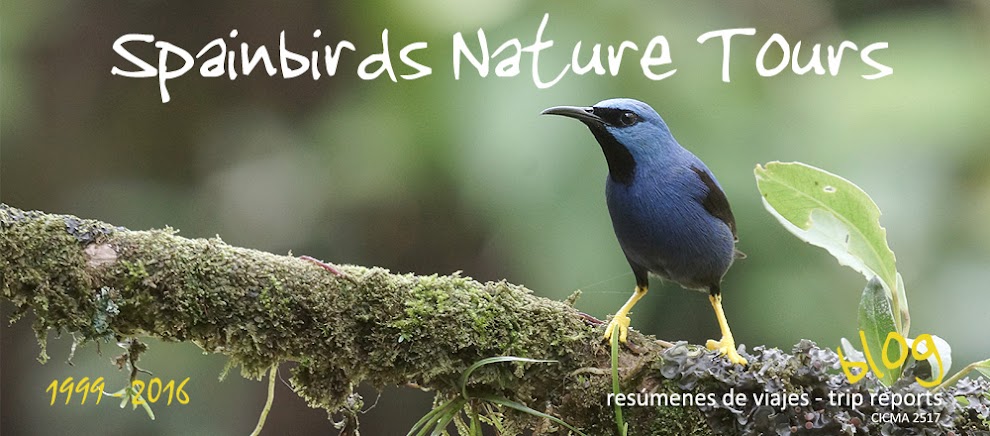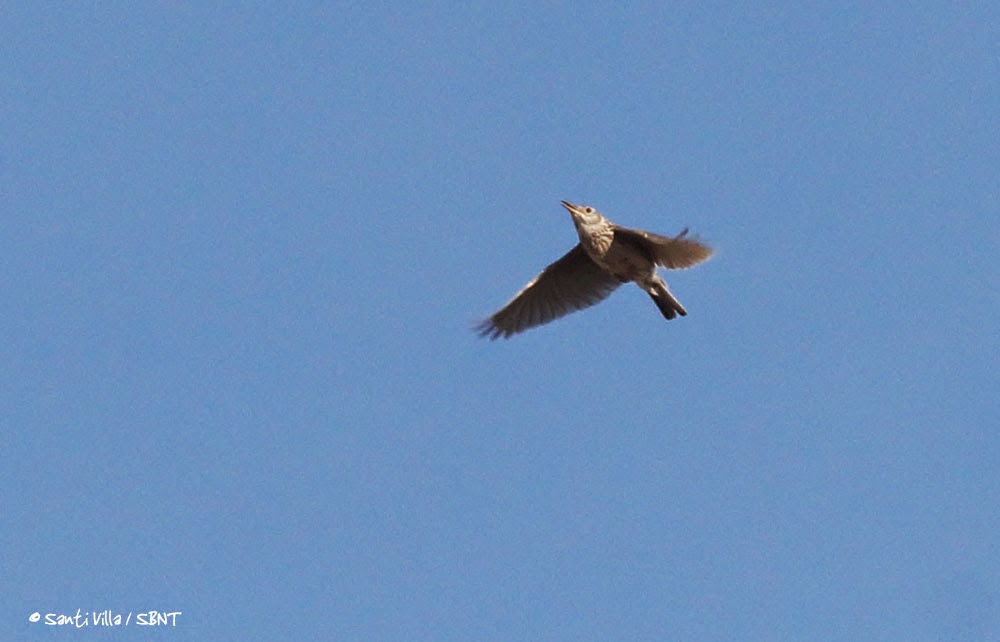Lady Bay Birders es un grupo de amigos, aficionados a la ornitología y la naturaleza, que han venido con nosotros ya en varias ocasiones. Anteriormente estuvimos con ellos en Doñana, Extremadura, La Mancha, Madrid... y en esta ocasión visitaban Picos de Europa con el principal objetivo de observar treparriscos.
Se puede decir que tuvimos suerte una vez más y además de ver treparriscos, tuvimos oportunidad de observar otras aves alpinas como chovas piquirrojas y piquigualdas, bisbita alpino, gorrión alpino y acentor alpino entre otros.
En los bosques y prados de Liébana también añadimos a nuestra selecta lista pico mediano, torcecuello, colirrojo real, alcaudón dorsirrojo, escribano cerillo, camachuelo, pito real ibérico y abejero europeo.
Las aves acuáticas curiosamente también tuvieron una importante presencia en este viaje, puesto que tanto a la ida como a la vuelta al aeropuerto de Santander, decidimos visitar los humedales de Santoña (el primer día) y las marismas de San Vicente de la Barquera y La Rabia (el último). Como resultado una interesante lista de limícolas que incluyó chorlito gris, chorlitejo grande, aguja colipinta, zarapitos real y trinador, archibebes común y claro, andarríos chico y correlimos gordo, común y tridáctilo.
En total 111 especies de aves registradas en 5 días. Además, una interesante selección de mariposas, orquídeas y reptiles, completaron un fantástico viaje que nos dio la oportunidad de hacer un buen repaso por la flora y fauna de estas impresionantes montañas.
A continuación algunas fotos tomadas durante aquellos días de mayo, donde la observación de dos treparriscos de camino a Horcados Rojos, fue sin duda lo más destacado.
La mañana que dedicamos a las zonas más altas (tomando el teleférico de Fuente De), fue de lo más productivo... una pareja de gorriones alpinos nos aguardaba en el cruce de la pista que va al refugio de Aliva.
Gorrión alpino / Snow Finch
Gorrión alpino / Snow Finch
Como se ha dicho, la observación de dos treparriscos fue de lo más destacado... nuestros amigos no pensaban tener la suerte de verlos tan cerca...
Treparriscos / Wallcreeper
Treparriscos / Wallcreeper
Treparriscos / Wallcreeper
Treparriscos / Wallcreeper
El macho fue especialmente colaborador e incluso se marcó un par de "cantos" frente a nosotros en lo alto de una gran roca... y a la altura de nuestros ojos.
Treparriscos / Wallcreeper
La hembra apenas se mostró, pero tuvimos la suerte de fotografiarla en vuelo...
Treparriscos / Wallcreeper
Acentores alpinos, quizás de las aves más comunes a 1,800 metros de altitud en esta parte de Picos de Europa
Acentor alpino / Alpine Accentor
Acentor alpino / Alpine Accentor
Chova piquigualda / Alpine Chough
Torcecuello euroasiático / Eurasian Wryneck
Entre las aves forestales cabría destacar la observación de una pareja de picos medianos (omitiremos la localidad, donde además este año volvieron a criar)... y la presencia del siempre llamativo colirrojo real... y que además frecuenta cada pueblo de estos valles.
Colirrojo real / Common Redstart
Melitaea athalia / Heath Fritillary
Neotinea ustulata / Burnt-tip Orchid
Un interesante insecto, mitad mariposa, mitad libélula... que suele verse en los prados de siega
Libelloides spp.
Melitaea athalia / Heath Fritillary
Himantoglossum Hircinum / Lizard Orchid
Mosquitero papialbo / Western Bonelli's Warbler
Orchis papilionacea / Pink Butterfly Orchid
Tarabilla común / Common Stonechat
Este lagarto ocelado, "acosado" por las cámaras, decidió huir trepando por una de mis piernas. Mejor fotografiarlo en un medio más natural.
Lagarto ocelado / Ocellated Lizard
En el puerto de San Glorio, además de herrerillos capuchinos y bisbitas arbóreos vimos varios verderones serranos, siempre inquietos y sin apenas parar en el suelo o en los árboles, también aquí un par de cucos sobrevoló nuestras cabezas... escribanos montesino y cerillo hicieron acto de presencia, mientras de fondo el alegre canto de totovías y alondras comunes.
Herrerillo capuchino / Crested Tit
Bisbita arbóreo / Tree Pipit
Calophrys rubi / Green Hairstreak
En el cercano collado de Llesba está el monumento al oso. Puede que no fuera una toma muy original pero aprovechamos para hacer la foto de grupo en este lugar. Falta el que escribe.
Águila calzada / Booted Eagle
Erebia triarius / de Prunner's Ringlet
Narcisus pseudonarcisus / Wild Daphodil
Alimoche común / Egyptian Vulture
Reyezuelo listado / Firecrest
Melitaea didyma / Spotted Fritillary
Además de disfrutar observando también tuvimos tiempo de ponernos en forma... eso sí, con un respiro de vez en cuando. Había que quemar las cenas copiosas que nos ofrecían cada noche en nuestro coqueto hotel rural.
El último día, después de conocer el castañar de Cabañes y Santa María de Lebeña, pusimos rumbo a San Vicente de la Barquera. Tras degustar una deliciosa comida en el puerto de esta localidad cántabra nos acercamos a los acantilados cerca de Comillas. Añadimos a nuestra lista alcatraz atlántico y comenzamos el regreso a Bilbao, donde dimos por finalizado el viaje.


























































